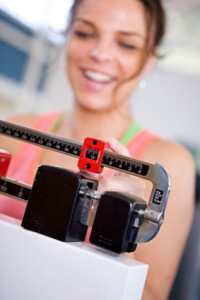In this article

Slow Start – Surefire Success and How to Avoid Injury.
So you haven’t been to the gym, on a walk, played basketball, etc. for years. But you used to be an animal! You had the resting heart rate of a marathon runner, and washboard abs. That was 20, 30, 40 or more pounds ago. You won’t be able to do the same workout routine you did when you were fit. Here’s what I’d recommend:
- Find your target heart rate
- Start with cardio
- Add in strength training
- Eat more protein
- Drink more water
- Eat less
Finding your target heart rate is simple: subtract your age from 220 to find your MAX heart rate. (i.e. if you are 40 years old, your max rate is 180) You will target 70 to 80 percent of your max heart rate of on minute followed by 2 to 3 minutes of a slower pace to get your heart to around 120 to 130 beats per minute (bpm). This is called interval training. It’s a great cardiovascular exercise and a good starting point in a workout routine. The great thing about interval training is it works no matter your fitness level. Once you become more fit, it will be harder to hit your workout heart rate zone because your heart is healthier and more efficient. So you might say, healthier begets healthier!
Starting with Cardio. You can start out doing interval training on cardio equipment or walking. If you haven’t worked out in a long time, if you’re carrying 20 pounds or more in extra weight, and if you have joint problems starting out on a stationary bike is a great choice. If you don’t have access to a stationary bike an elliptical machine is my second choice. These are both very low impact and not too hard on your joints. (If you have bad knees, the elliptical trainer may be a better choice for you depending on what is wrong with your knees.) Other good choices are treadmill or even walking outdoors; however, most people will find a machine is easier to monitor speed and progress. Avoid running in the beginning. Your heart and joints more than likely aren’t ready yet.
If you can handle this six days a week, that should be your goal. If not, try every other day. Consistency is critical in meeting your goals.
Strength Training. After two weeks, or if you feel up to it at the beginning try doing an entry level strength training program. I’ll be going over this more in depth in future articles but the best thing for your joints at this point would be weight machines you’ll find in most gyms. I’d stay clear of the free weights for now. A side benefit is most gyms have individual machines for each muscle group. You can work through each machine for upper body one day, then lower body and so on. Don’t lift too heavy in the beginning. Your joints aren’t ready for it. You can do three sets of 15 repetitions of each exercise for each muscle group.
Your workout schedule may look like this:
- Monday – Upper body workout. 30 – 45 minutes
- Tuesday – 20 minute cardio workout.
- Wednesday – Lower body workout. 30 – 45 minutes
- Thursday – 20 minute cardio workout.
- Friday – Upper body workout. 30 – 45 minutes
- Saturday – 20 minute cardio workout.
- Sunday – REST.
The following week I would do lower body on Monday and Friday, and upper body on Wednesday and keep alternating each week.
Protein. As you workout, your bodies protein requirements change to meet the demands of rebuilding muscle tissue. Most people don’t get enough protein. You need it to rebuild your lean body mass. Starting out it’s a good idea to shoot for .5 gram protein for every pound you weigh. It may be hard to do this without a protein supplement like a shake or protein bar. These needs will change as your body does, but this is a good starting point. I wouldn’t be concerned about any other dietary supplements other than a good protein shake just starting out if even that. You can increase you protein intake by eating more lean chicken, cottage cheese, eggs, etc.
Water consumption is another crucial step. In fact, I’d say if you’re really serious about losing weight then you should stop drinking your calories. And diet sodas, too! Water will both make you feel less hungry between meals and it’s very important for many vital functions of your body. Target .5 ounce for every pound you weigh. By all means, if you are drinking this much and you’re still thirsty – DRINK MORE. Your body will tell you if it needs more water.
Eat less. You don’t have to go on a fancy diet to begin with. You may not even have to stop going to fast food restaurants in the beginning. Just eat less. If you are eating a combo meal from a drive through and you normally get the Large Combo, get the Medium Combo. You’ll reduce the number of calories you get each week doing just this simple thing.
I’m not saying you want to keep eating this way forever. Heck, you may not want to eat out at fast food joints when you are living a healthy lifestyle. Your cravings will change.
Just imagine your scale showing that you oactually LOST weight this week instead staying the same or worse – gaining! You can do it! It’s not hard. Change one thing. Add in another. Pretty soon you’ll find yourself shopping for news clothes because the old stuff is too big!
Sign up for our free newsletter for more tips on keeping fit.
By: David Simpson